I grew a radish tree this season. A tree? you might ask, with an eyebrow raised skeptically. But when I show you the 5-foot beast that just kept growing and growing in my garden — started from seed last summer and then overwintered — you’ll realize that yes indeed, I grew a radish tree.
This ebony beauty is Black Spanish radish (Raphanus sativus L. var. niger), a winter radish that grows much longer (over time) and larger (in size) than spring radishes you might be more familiar with (like the petite French Breakfast variety or the little red globes you see in the grocery store).
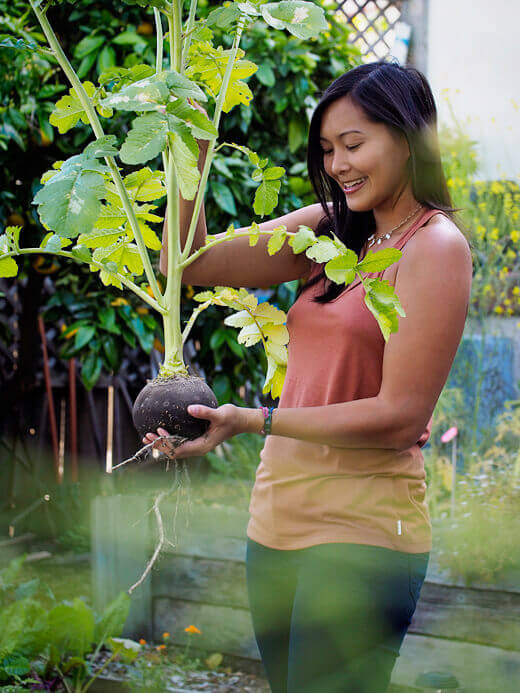

A few seasons ago, I grew the long version of Black Spanish radish and while it was a lovely variety to try, it turned into a massive root the length of my forearm and the size of my calf! (Okay, I admit I did leave it in the ground a bit longer than I should have.)
Since I wasn’t keen on excavating my radish crop with a shovel this season, I decided to try the round version, which is typically harvested when it reaches 3 to 4 inches in diameter.
Except… I didn’t harvest mine when it was 3 to 4 inches in diameter. Around the time I signed my book deal, I realized that I needed to grow some of the hard-to-find items I was developing recipes for, such as radish pods. I decided to let the entire crop keep growing through spring, in hopes of having an abundant supply of seed pods to photograph and work with.
Up until last week, I’d actually forgotten about the black radishes, as I had several beds filled with flowering and seeding plants left over from winter. When I started plotting out where the new summer crops would go, I spotted a row of neglected radishes that had grown beyond their suggested size. These things were over 6 inches in diameter with mighty flower stalks that nearly towered over me and hefty seed pods hanging from spindly stems.
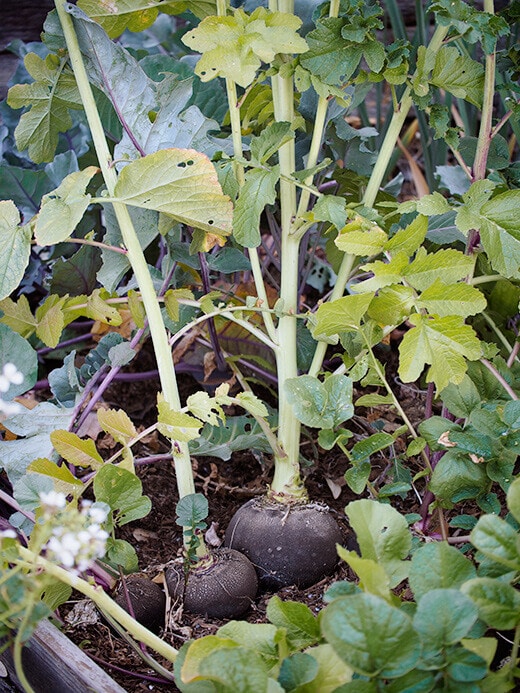
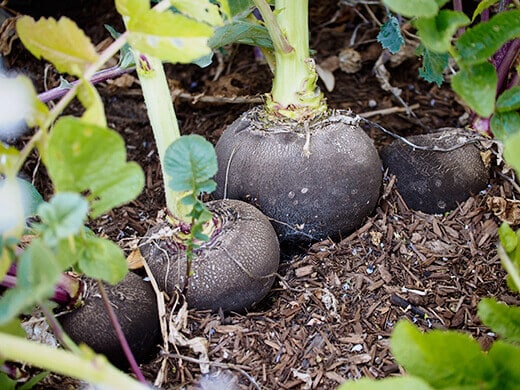
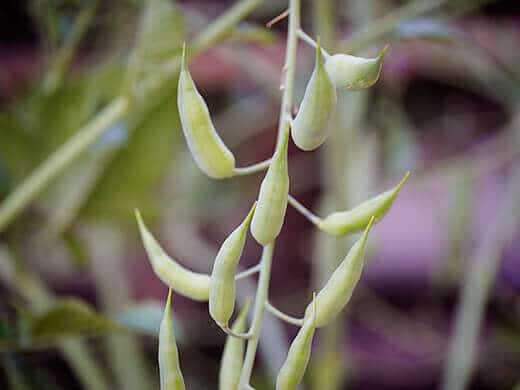
I just assumed that at this size, the radishes would be too tough and woody to eat. I was going to slice off what tender bits I could and compost the rest, but imagine my surprise when I sliced straight through the middle of the radish and the knife went in like butter.
The snow white flesh was crisp and tender, and the inky black skin was just as thin and edible as a younger radish. It tasted pleasantly peppery when raw, and cooked up beautifully with a pan full of other root vegetables. In many ways, it reminded me of a turnip. The other radishes we pulled up were the same — totally overgrown and intimidating at first look, but completely tender at the core.

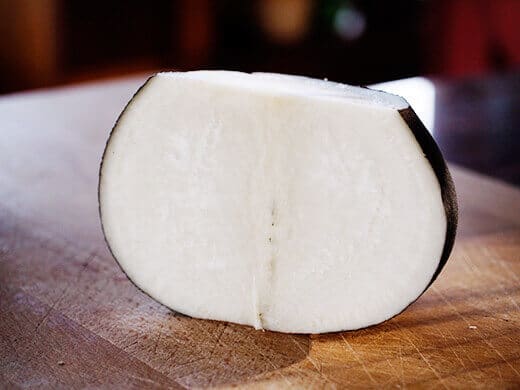
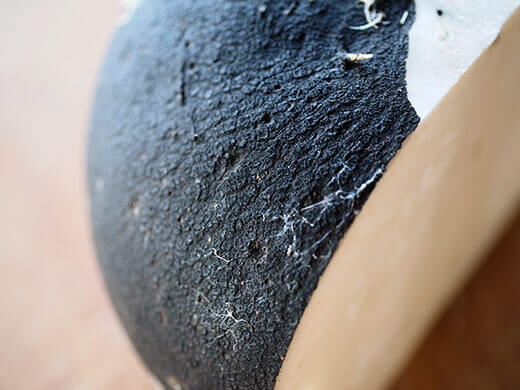
Black Spanish radishes aren’t too common in this country, but they’ve been used in holistic medicine for centuries around the world. One 2012 study in Mexico found that the juice extracted from black radishes was effective in lowering cholesterol and treating gallstones. Another 2012 study, conducted by the University of Wisconsin, found that black radishes protected against bone marrow toxicity. A Wisconsin study in 2007 focused on the liver-detoxifying properties of black radish, which had higher concentrations of a glucosinolate unique to the radish family. In Indian folk medicine, black radish (or mooli, as it’s known) has been used traditionally as a liver tonic, and Chinese herbal medicine uses the root for improving pulmonary health.
But all these health benefits don’t end with the roots. As with many root vegetables, the greens actually have greater antioxidant power; radish leaves contain more vitamin C and calcium than their below-ground counterparts.
With large radishes like these, I love to use the leaves in soups and sautes, where they cook up just like kale or chard. (If you’ve been reading the blog for a while, you might remember the first recipe I ever posted, for potato and radish leaf soup — still one of my favorites for how easy and hearty it is.) As for the bulb, those Germans got it figured out: They slice it thinly, sprinkle with salt, and snack on it with a mug of beer. Turns out, black rettich (radish), salt, bread, butter, and beer is a beer garden favorite. I even found a German lager-style beer called Black Radish! Meant to wash down a good brat, I’m sure.
Grow your own by starting seeds in late summer, and they’ll be ready for harvest in fall. Or, go big like I did and overwinter them for hefty bulbs in spring!


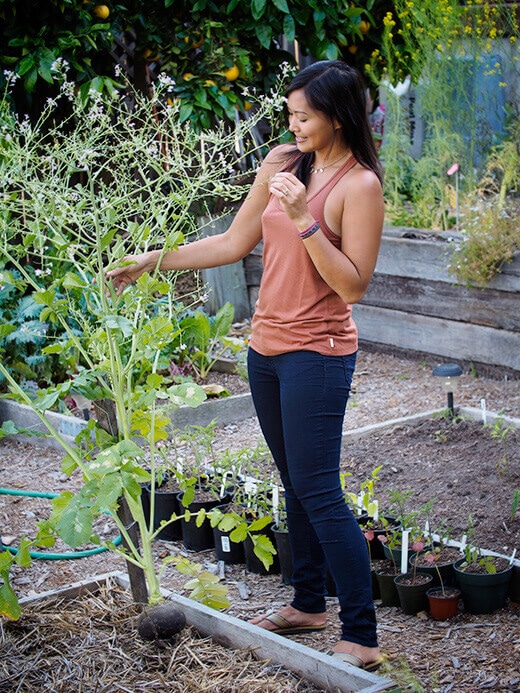













Mooli can refer to daikon, but it’s also a term associated with black radish, e.g. black mooli. In my research I’ve found that mooli tends to be a general term for any member of Raphanus sativus, but more often used with the larger or elongated varieties.
Looks great, but it’s not a Mooli. A mooli is a large white Asian radish, also known as a daikon: http://en.wikipedia.org/wiki/Daikon
I love your blog!!
I have been gardening for over twenty years and I always see something new here.:)
Thank you for the kind compliment!
RT @theGardenBetty: RT @RVR_Aix: These are my new favs from #provence market. Crisp & #spicy! “@theGardenBetty: Black Is the New Radish htt…
RT @RVR_Aix: These are my new favs from #provence market. Crisp & #spicy! “@theGardenBetty: Black Is the New Radish http://t.co/uKJCSWl5A2”
RT @FredJaicks: Wow! That’s a big radish! RT @theGardenBetty: Blogged on Garden Betty: Black Is the New Radish http://t.co/uKJCSWl5A2
These are my new favs from #provence market. Crisp & #spicy! “@theGardenBetty: Black Is the New Radish http://t.co/eNG4lvAois”
Wow! That’s a big radish! RT @theGardenBetty: Blogged on Garden Betty: Black Is the New Radish http://t.co/ktqtth25bX
Blogged on Garden Betty: Black Is the New Radish http://t.co/UTXwCAPDej < TY for RT! @ExtravagantG
This radish can grow up to 6″ in diameter! Start your own from seed in summer. Black Is the New Radish http://t.co/l8fGwKg35y #gardenchat
Holy moly!
I figured it would be too woody as well! I like radishes fresh but I don’t know any other way to eat them except in a salad. Ideas anyone?
Treat them as any other root vegetable. I like them roasted, braised or sauteed. Under heat, the peppery flavor mellows out and the texture is akin to a carrot. I wouldn’t say they completely sweeten when cooked, but they do caramelize beautifully. I like to pair them with stronger sauces and glazes, such as soy sauce, balsamic or red wine vinegar, or white wine.
This massive and oddly beautiful radish has inky black skin but snow white flesh. Black Is the New Radish http://t.co/5wzD1FUsnJ #gardenchat
One of the unique winter radishes I grew from @rareseeds: Black Is the New Radish http://t.co/pFycGky5z9 #gardenchat #gardening
This intimidating-looking radish grew up to 6″ in diam with stems over 5′ tall! Black Is the New Radish http://t.co/eOJHQ2wImL #gardenchat
This is soooo cool!! Sharing on my page!
I grew a 5-foot radish tree this season. A what? That’s right: Black Is the New Radish http://t.co/FO5Asn8E4m #gardenchat #gardening
Cool radish! I was at my local hydroponics store yesterday buying pots and they had a kale tree growing! It was about 4- 4&1/2 feet tall and had only been growing for 4 months! That got me thinking about trying out outdoor hydroponics (outdoor because I don’t want to spend $$$ on lights). Anyways, very cool how you got those results from just regular gardening!
Kale/collard trees are fun, though they’re an actual long-stemmed variety of brassica while my radish “tree” is just crazy bolting right now!
Your radishes are amazing, my first thought was that they were probably not edible, but not so. I’m seeing a lot of radish dishes in your future.
A lot of radish dishes just with this one radish! 😉
I saw seeds for this, probably in the Baker Creek catalog. Should have ordered them!
You can still order them — they’re best grown in the fall.
RT @theGardenBetty: Blogged on Garden Betty: Black Is the New Radish http://t.co/UTXwCAPDej
RT @BG_garden: Black Is the New Radish:
I grew a radish tree this season. A tree? you might ask, with an eyebrow raised skep… http://t.c…
RT @BG_garden: Black Is the New Radish:
I grew a radish tree this season. A tree? you might ask, with an eyebrow raised skep… http://t.c…
Black Is the New Radish:
I grew a radish tree this season. A tree? you might ask, with an eyebrow raised skep… http://t.co/qmpvyLOGRv
Blogged on Garden Betty: Black Is the New Radish http://t.co/UTXwCAPDej